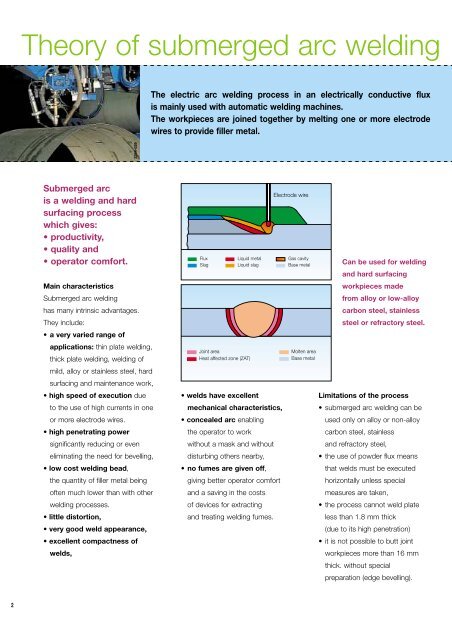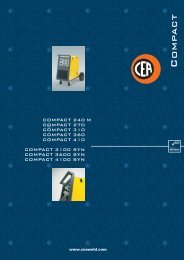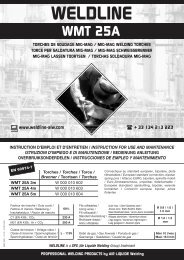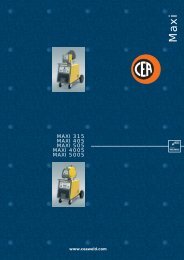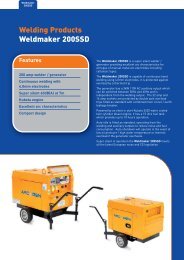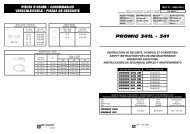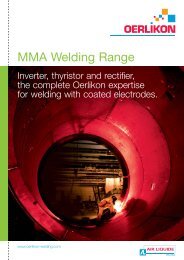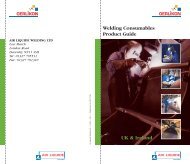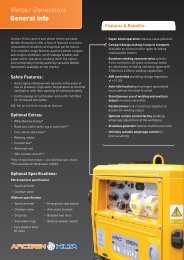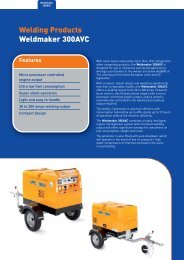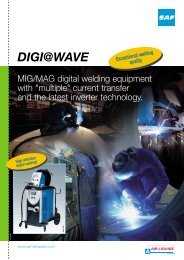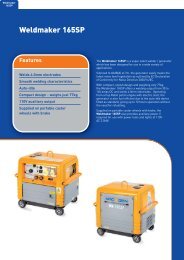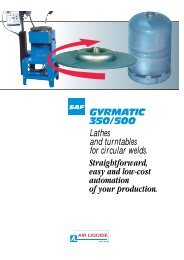SUBARC - OERLIKON
SUBARC - OERLIKON
SUBARC - OERLIKON
You also want an ePaper? Increase the reach of your titles
YUMPU automatically turns print PDFs into web optimized ePapers that Google loves.
Theory of submerged arc welding<br />
The electric arc welding process in an electrically conductive flux<br />
is mainly used with automatic welding machines.<br />
The workpieces are joined together by melting one or more electrode<br />
wires to provide filler metal.<br />
2264-029<br />
Submerged arc<br />
is a welding and hard<br />
surfacing process<br />
which gives:<br />
• productivity,<br />
• quality and<br />
• operator comfort.<br />
Main characteristics<br />
Submerged arc welding<br />
has many intrinsic advantages.<br />
They include:<br />
• a very varied range of<br />
applications: thin plate welding,<br />
thick plate welding, welding of<br />
mild, alloy or stainless steel, hard<br />
surfacing and maintenance work,<br />
• high speed of execution due<br />
to the use of high currents in one<br />
or more electrode wires.<br />
• high penetrating power<br />
significantly reducing or even<br />
eliminating the need for bevelling,<br />
• low cost welding bead,<br />
the quantity of filler metal being<br />
often much lower than with other<br />
welding processes.<br />
• little distortion,<br />
• very good weld appearance,<br />
• excellent compactness of<br />
welds,<br />
Flux<br />
Slag<br />
Liquid metal<br />
Liquid slag<br />
Joint area<br />
Heat affected zone (ZAT)<br />
• welds have excellent<br />
mechanical characteristics,<br />
• concealed arc enabling<br />
the operator to work<br />
without a mask and without<br />
disturbing others nearby,<br />
• no fumes are given off,<br />
giving better operator comfort<br />
and a saving in the costs<br />
of devices for extracting<br />
and treating welding fumes.<br />
Electrode wire<br />
Gas cavity<br />
Base metal<br />
Molten area<br />
Base metal<br />
Can be used for welding<br />
and hard surfacing<br />
workpieces made<br />
from alloy or low-alloy<br />
carbon steel, stainless<br />
steel or refractory steel.<br />
Limitations of the process<br />
• submerged arc welding can be<br />
used only on alloy or non-alloy<br />
carbon steel, stainless<br />
and refractory steel,<br />
• the use of powder flux means<br />
that welds must be executed<br />
horizontally unless special<br />
measures are taken,<br />
• the process cannot weld plate<br />
less than 1.8 mm thick<br />
(due to its high penetration)<br />
• it is not possible to butt joint<br />
workpieces more than 16 mm<br />
thick. without special<br />
preparation (edge bevelling).<br />
2


